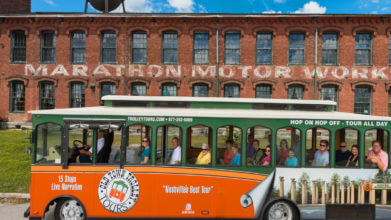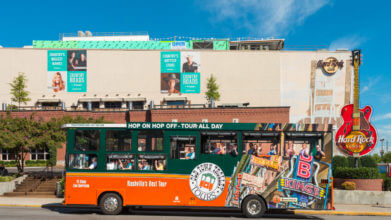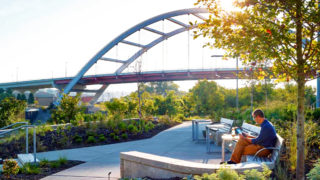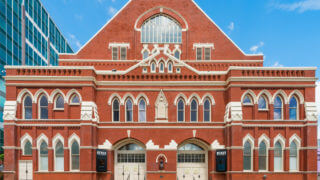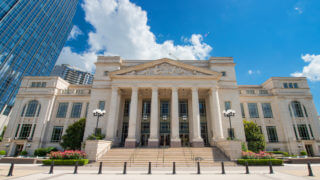The Parthenon
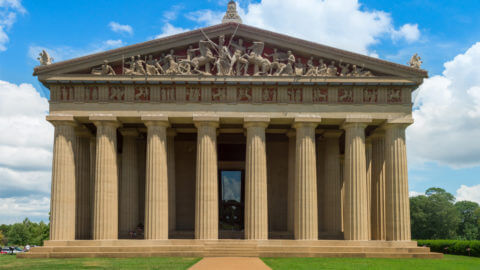
Containing a full-scale replica of the original statue of Athena, the Parthenon was constructed in 1897 for the Tennessee Centenary Exposition. The 42-foot tall Athena Parthenos sculpture is the tallest indoor artistic work of its kind in the Western Hemisphere. While other exposition buildings were removed, the Parthenon was preserved as a museum. In addition to its elaborate statue, the building houses sculptures and paintings by 19th- and 20th-century American artists. A precise copy of the original Parthenon in Athens, the edifice sits atop a rolling hill in Centennial Park adjacent to a duck pond.
Discover the magic of Nashville and embark on a historical adventure!
Listed on the National Register of Historic Places, the Parthenon is the centerpiece of Centennial Park. The world’s only full-scale replica of the ancient Greek temple in Athens, the edifice was originally constructed as part of the Tennessee Centennial and Exposition that was held in 1897. The Parthenon is the only structure preserved from the historic event. The site now serves as the backdrop for Nashville’s art museum and the 42-foot-tall statue of Athena Parthenos designed by Alan Le Quire in 1990.
History of the Parthenon
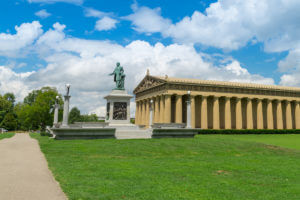 In the 19th century, Nashville earned the nickname “The Athens of the South” because of the number of colleges and universities located within the city and the surrounding areas. It was also highly regarded for its public school system and commitment to education. This prestigious title inspired the local residents when they chose a theme to commemorate the 100th anniversary of the Volunteer State’s admission to the Union. Major Eugene Castner Lewis, director of the exposition committee, suggested that the city erect a full-scale replica of the ancient Parthenon in Athens to represent the city and state at the festival. The temple is considered the pinnacle of classical architecture. The structure features plaster replicas that are direct copies of the Parthenon Marbles that were discovered in the Naos walls. Dating from 438 B.C., the originals are housed in the British Museum in London. While many of the buildings at the exposition were based on ancient designs, the Parthenon was the only exact replica.
In the 19th century, Nashville earned the nickname “The Athens of the South” because of the number of colleges and universities located within the city and the surrounding areas. It was also highly regarded for its public school system and commitment to education. This prestigious title inspired the local residents when they chose a theme to commemorate the 100th anniversary of the Volunteer State’s admission to the Union. Major Eugene Castner Lewis, director of the exposition committee, suggested that the city erect a full-scale replica of the ancient Parthenon in Athens to represent the city and state at the festival. The temple is considered the pinnacle of classical architecture. The structure features plaster replicas that are direct copies of the Parthenon Marbles that were discovered in the Naos walls. Dating from 438 B.C., the originals are housed in the British Museum in London. While many of the buildings at the exposition were based on ancient designs, the Parthenon was the only exact replica.
As the first building erected for the exposition, the Parthenon was originally constructed from plaster, wood and brick. The planners never intended that the building remain a permanent structure after the exposition ended. However, the cost of demolition and the popularity of the building saved it from being knocked down. Because the original structure experienced deterioration from the elements, it was replaced by the current concrete edifice.
Construction of the landmark building was performed from 1920 until 1925. The interior was finished six years later. The edifice features 7-ton bronze entrance doors. Situated on the east and west ends of the building, the entryways are the largest doors of their kind in the world. The Parthenon has been the backdrop for a number of celebrations, special events and theatrical productions.
Must-See Exhibits
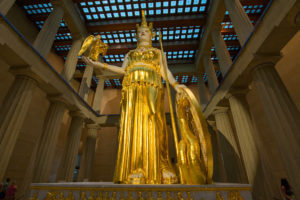 Paintings & Sculptures
Paintings & Sculptures
The Parthenon galleries display a collection of 63 Impressionist oils on canvas paintings dating from 1765 to 1923 produced by a variety of American artists. While the primary focus of the collection is landscapes, there are also four seascapes and eight portraits. These pieces formed just a portion of James M. Cowan’s personal collection when he donated them to the museum. The institution also hosts a variety of temporary and traveling exhibits. There are also numerous plaster reproductions of ancient sculptures and other marbles.
Statue of Athena
The east room on the second floor of the museum is the setting for the statue of Athena, the tallest indoor statue in the country. Tipping the scales at approximately 12 tons, the figure was re-created based on careful scholarly work as to the appearance of the long-lost original statue by Phidias that adorned the ancient temple. It took eight years to complete the statue. The gold leaf was added in 2002 and this colorfully adorned figure carries a shield in her left hand and a life-sized statue of Nike in her right palm. A 20-foot-tall serpent appears between the body of Athena and her shield. The centerpiece statue is surrounded by smaller sculptures.
Visitor Information
Hours of Operation & Attraction Information
The Parthenon is open Tuesday through Thursday from 9 a.m. until 7:00 p.m, Friday through Saturday from 9 a.m. until 4:30 p.m. and Sunday from 12:30 p.m. until 4:30 p.m. In addition to Mondays, the museum is closed on Thanksgiving Day and the following Friday as well as Christmas Eve, Christmas Day and New Year’s Day. It is estimated that most visitors spend an average of 40 minutes touring the various exhibits. You can spend more time based on how in-depth you wish to explore each display. The tours are self-guided, however pamphlets and docents are available to help guide you through the museum. The Parthenon is a free public Wi-Fi hot spot. The museum does not allow pets, food or drinks as well as backpacks and oversized bags. Strollers are welcome.
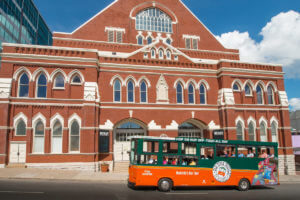 Getting to the Parthenon
Getting to the Parthenon
Get MORE out of your summer in Nashville aboard the iconic Old Town Trolley and see the best first!
When you reach Centennial Park, there are numerous signs directing motorists to the nearby park spaces. Although parking is a short walk from the entrance to the Parthenon, the limited spaces generally fill up fast. The ideal way to reach Centennial Park and the Parthenon is aboard Old Town Trolley. This sightseeing tour lets you sit back and enjoy a fun and educational narration while experiencing the best that Nashville has to offer.
Things to Do Nearby
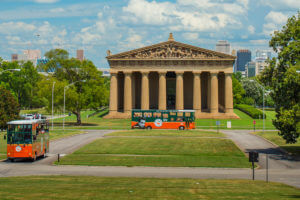 Centennial Park
Centennial Park
After you visit the Parthenon, you can tour the rest of the attractions found in Centennial Park. As the host for numerous festivals and fairs throughout the year, the expanse of lawn is great for picnics and other family activities. Centennial Park features walking paths, a duck pond and an amphitheater that hosts outdoor concerts and the city’s Shakespeare in the Park Festival. The urban open space also has displays of a historic aircraft and locomotive along with several monuments and memorials, including artwork celebrating women’s suffrage and the city’s founder James Robertson.
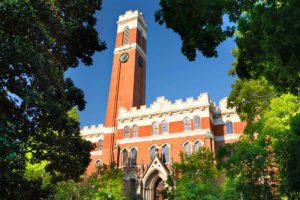 Vanderbilt University
Vanderbilt University
Designated a national arboretum, the Vanderbilt University campus contains more than 6,100 specimens from over 190 species of trees, shrubs and other plantings. Gracing the site before the Revolutionary War, the Bicentennial Oak is the oldest and most famous tree on campus. The most popular species present is the Southern Magnolia. The campus is also the setting for several historic buildings listed on the National Register of Historic Places.
#VacayYourWay

Get ready to #VacayYourWay with Old Town Trolley in Nashville! Treat yourself to the relaxing vacation you deserve, whether you’re a history buff, a sightseer, or an adventurous family. From the Country Music Hall of Fame to the Ryman Auditorium and everywhere in between, see the best of Nashville with live narration from our friendly and knowledgeable guides.

